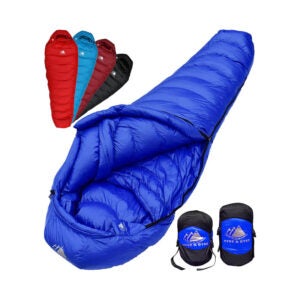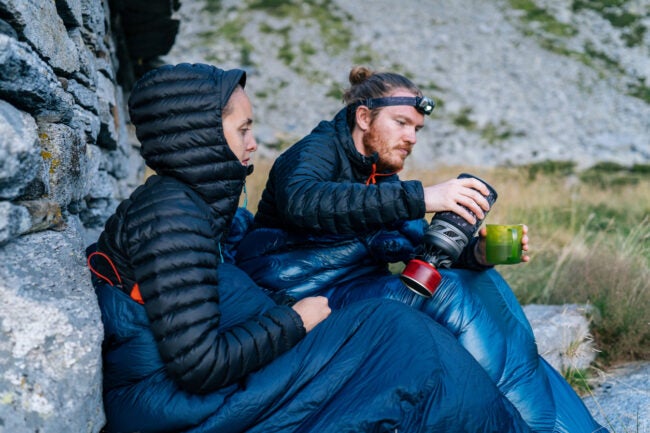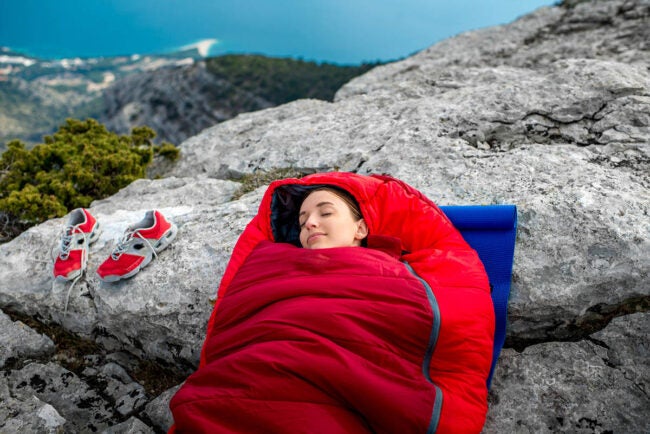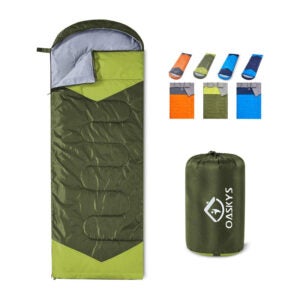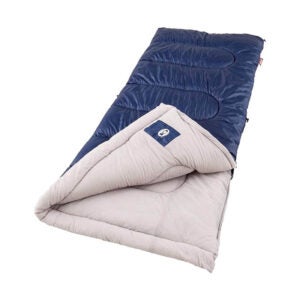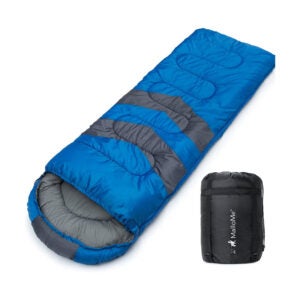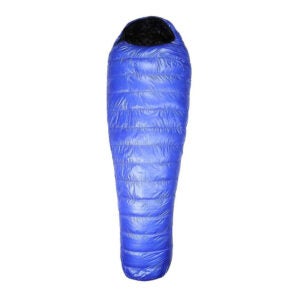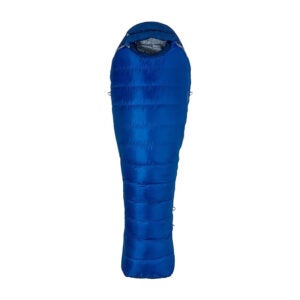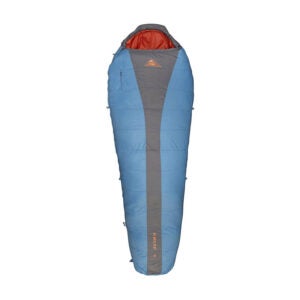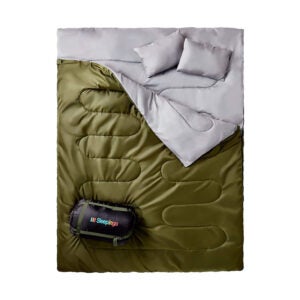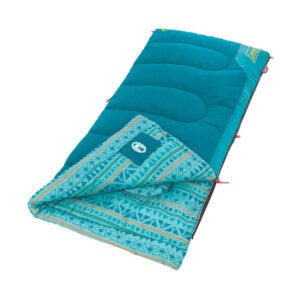Sleeping bags are a big part of the camping experience and often mean the difference between a good night’s rest or fitful sleep. The right one keeps campers warm and dry, while the wrong bag may twist, bunch, and be too hot or cold. The best sleeping bag has an adequate loft, the right weight for the weather, and easily packs down for storage. They come in various shapes, sizes, and lengths to suit different sleepers and environments. This guide will outline types of sleeping bags, what to look for when shopping, and top recommendations to assist your search.
- BEST OVERALL: Hyke & Byke Quandary Hydrophobic Down Sleeping Bag
- BEST BANG FOR THE BUCK: oaskys Camping Sleeping Bag
- BEST FOR CAMPING: Coleman Brazos Cold Weather Sleeping Bag
- BEST FOR SUMMER: MalloMe Camping Sleeping Bag
- BEST FOR WINTER: Western Mountaineering Ultralite Mummy Sleeping Bag
- BEST FOR BACKPACKING: Marmot Sawtooth 15F-Degree Down Sleeping Bag
- BEST FOR HUNTING: Kelty Cosmic 20 Degree Down Sleeping Bag
- BEST DOUBLE: Sleepingo Double Sleeping Bag
- BEST FOR KIDS: Coleman Kids 50 Sleeping Bag
Types of Sleeping Bags
Sleeping bags are often categorized by season, which indicates their general temperature range. When deciding, consider what type of sleeping pad and clothing will be used with the bag. For example, some sleeping pads provide extra ground insulation, so a camper may not need as warm of a bag. Additional layers of clothing also offer extra insulation and affect sleeping comfort.
Summer
Summer bags are typically rated for 30 to 40 degrees Fahrenheit and up. These lightweight bags insulate the body on cool to warm evenings. They don’t require as much filling to provide adequate insulation, so they’re often of lighter weight than winter bags. However, some summer bags feature less expensive polyester fills that weigh more than the more costly, but lightweight, natural down in winter and three-season bags.
Summer bags are made of different materials based on how or where you plan to use them, car camping versus overnight hiking, for example. A bag designed for car camping may have a cotton or flannel lining, which enhances breathability but also adds weight. A summer bag suitable for overnight hiking has a nylon/polyester outer and inner shell that easily packs down for a small footprint inside a backpack.
Three-Season
Three-season sleeping bags work best in weather from 15 to 40 degrees Fahrenheit. They’re warm enough for most camping needs. Like summer sleeping bags, three-season bags come in different types and styles to accommodate other uses.
Rectangular bags weigh more and aren’t as heat efficient as semi-rectangular or mummy bags, but they’re often more comfortable for car camping or hunting. Three-season semi-rectangular and mummy bags have less air in the sleeping bag for the body to heat, so they stay warmer. These models are the best sleeping bags for those who camp frequently but not in weather below 15 degrees.
Winter
Winter sleeping bags are designed for temperatures below 15 degrees Fahrenheit. For extreme adventurers, there are also subzero bags meant for extreme sports and excursions. These bags contain the highest quality down or synthetic filling and often have a high-loft down that helps trap more air without increasing weight.
Water-resistant exteriors, hoods, stuff sacks, and stash pockets are essential with these bags. These models require high-quality filling and materials to maintain adequate body heat, contributing to their high price.
What to Consider When Buying a Sleeping Bag
A few considerations like weather, comfort levels, and climate help determine the best sleeping bag. For example, people who camp in wet climates need a bag with a water-resistant exterior and hydrophobic filling. Campers who frequently venture into the woods may want to spend more on a model that’s usable for several seasons, offers extra zippers for added comfort, and packs down to a smaller size. It comes down to how and when you plan to use the bag most often.
Season
The bag’s season communicates a lot about the design. Summer bags are lighter with less filling. However, if temperatures drop below 40 degrees Fahrenheit, the chill can sneak through. These bags work for summer sleepovers, backyard camping, and car camping at low elevations.
The majority of people get the most use out of a three-season sleeping bag. These bags work for temperatures down to 15 degrees, which makes them appropriate for camping in the mountains, where, even in the heat of summer, nighttime temperatures may drop below 40 degrees.
Winter or subzero bags are overkill for most people. They’re incredibly warm and often full of technical fabrics and fillings to reduce weight and maximize heat efficiency. Campers who brave the weather in fall and winter benefit most from these bags.
Warmth Rating
Warmth or temperature rating systems allow buyers to compare sleeping bags of different brands. There are two systems: ISO and EN. EN ratings are the older of the two systems, and the ISO ratings exist to eliminate inconsistencies across labs.
Sleeping bags receive two temperature ratings known as comfort and limit with the EN and ISO systems. A comfort rating designates the lowest temperature at which a “cold sleeper” will stay comfortable. Comfort ratings typically appear on women’s sleeping bags.
Limit ratings indicate the lowest temperature at which a “warm sleeper” stays comfortable. They’re typically used to describe men’s and unisex sleeping bags. Keep in mind that warmth ratings vary across brands and models. ISO and EN ratings can help you compare bags, but they’re not a guarantee.
Material
The climate and type of travel or camping determine the best sleeping bag materials. Sleeping bags made with a nylon or polyester shell with a synthetic filling work best in wet climates because the insulation still keeps the body warm if the sleeping bag gets wet. If down gets wet, it becomes almost useless at maintaining body heat. Some nylon and polyester shells have water-repellent or -resistant coatings as well.
A nylon shell with a natural down filling generally keeps the body warmer in a dry climate without adding extra weight. However, not all down insulates the same. The loft of a down sleeping bag indicates the fluff factor of the down. Fluffier down traps more air but minimizes weight. Summer sleeping bags don’t have to keep people as warm, so they typically have lower lofts or synthetic fillings.
Size and Weight
Sleeping bags work by keeping body heat in the bag to warm the sleeper. The less air that needs to be heated, the easier it is to stay warm. A sleeping bag that’s too small leaves the head and core exposed, losing valuable body heat. On the other hand, one that’s too long has extra air space, making it harder to maintain a comfortable body temperature. The basic sleeping bag sizes include men’s, women’s, and children’s, but there are models made for those over 6 feet 1 inch tall as well. Women’s bags may have wider hips, and men’s, broader shoulders to accommodate different body shapes.
Today’s hikers minimize pack weight in any way possible, including with their lightweight sleeping bag. Down sleeping bags weigh less in comparison to the warmth they offer, but they’re also some of the highest-priced models on the market. For those on a budget, synthetic down fillings also cut weight and provide adequate warmth, but they don’t compare to natural down.
Shape and Comfort
Comfort generally comes down to materials and the sleeping bag’s shape. Some sleeping bags have slick nylon liners that may catch on dry skin. Other bags have soft cotton or flannel that adds weight but feels luxurious. Each camper will have to decide what characteristics are most important and necessary for a good sleep.
The shape also plays a significant role in comfort and warmth. Standard profiles are rectangular, semi-rectangular, mummy, and double. Rectangular bags are most often used for car camping and summer sleepovers because they weigh more and aren’t as efficient at regulating body temperature. With their tight-contoured shape, mummy bags offer the best installation and warmth, but they can restrict movement. Semi-rectangular bags fall in between rectangular and mummy bags. They are a great compromise for those who need a little more wiggle room than a mummy bag offers. Finally, a double sleeping bag is large enough to share and is generally used only for car camping.
Additional Features
The most common extra features include sleeping bag shells, sleeping bag hoods, extra zippers and zipper shields, and a stash pocket.
Sleeping bag shells often have a durable water-repellent (DWR) finish to protect down installation. A sleeping bag hood tightens over the head, locking in heat and leaving only the face visible.
Dual zippers on either side of the bag provide extra ventilation options. If the camper gets too warm, one or both sides of the bag can be opened to cool the body. Zipper shields prevent cold air from seeping in through the zipper. These shields can also keep the fabric from getting caught in the zipper.
Our Top Picks
The following recommendations meet the goal of each sleeping bag’s design. Campers get what they expect with these models, ranging from summer sleeping bags to hunting sleeping bags. Many of them have extra features like hoods and stash pockets to make camping more comfortable and convenient.
Photo: amazon.com
The Quandary stands out for its unique design that maximizes heat retention, water-resistance, and compressibility. A filling made of 650 fill power duck down provides excellent loft and warmth. Yet all three sizes of the three-season Quandary weigh less than 3 pounds, keeping pack weights light.
When the description says hydrophobic, it’s not necessarily talking about the down but the shell. A water-resistant treatment protects the down from moisture to maintain body heat better. Horizontal baffles, or pockets, keep the down in place. Note that its narrow shoulder design may not work for those with a broader-than-average build.
Photo: amazon.com
The oaskys Camping Sleeping Bag provides the sleeping bag essentials in three sizes and several color combinations. It’s advertised as a three-season bag but typically works better for summer camping, with minimum temperatures between 35 and 50 degrees Fahrenheit.
The rectangular design leaves adequate space to toss and turn, while the hood provides excellent insulation on cold nights. The polyester fill and waterproof fabric provide heat even if water gets on the bag. It also comes in a single or double design made for two. This isn’t the bag for chilly temperatures, so if cold mountain nights are in the plans, another bag may be more suitable.
Photo: amazon.com
This rectangular Coleman sleeping bag is filled with 100 percent lightweight, hollow polyester. The hollow core of the polyester traps heated air to maintain body warmth. A plush inner liner feels comfortably soft and warm and extends over the opening seam of the sleeping bag, so there are no seams against the face.
Two special features are highly useful for camping. A roll-control feature locks the edges of the bag together to keep them straight when rolling it. It also includes a quick cord that snaps and locks into place once the bag is rolled. The only downside with this model is that there’s no hood for those extra cold nights.
Photo: amazon.com
The MalloMe Camping Sleeping Bag is suitable for three seasons, but the zipper design provides ventilation options that are best for warm summers. It’s got the roomy rectangular design most casual campers prefer but with a hood for when evenings get cooler than expected.
A waterproof shell protects the sleeper from dew or an unexpected rainstorm. While this isn’t a super-lightweight sleeping bag, at only 4.2 pounds, it could work for an overnight summer trip. The included stuff sack makes packing it that much easier. This model also comes in three colors and a double-size option.
Photo: amazon.com
There’s no messing around when hypothermia is on the horizon. The Western Mountaineering Ultralite Mummy Sleeping Bag provides the kind of insulation needed for mountain climbing, backcountry skiing, and extreme winter camping.
Horizontal baffles house the 850+ fill power goose down. With down of that quality, the sleeping bag keeps the sleeper warm but does so with a total weight of only 2.5 pounds. The mummy shape and hood utilize as much body heat as possible to keep heat in and cold out. The only downside with this model is the high price, but for those who push the physical limits, it’s worth it.
Photo: amazon.com
At a light 2 pounds 8 ounces, the Marmot Sawtooth sleeping bag takes up a minimal amount of space and adds little weight to a pack. Yet, it’s warm enough for temperatures down to 15 degrees Fahrenheit. It’s filled with 650 fill power down that’s treated with a down defender to protect it from losing heat when wet.
Stretch baffles provide a snug fit, and the hood locks heat inside. Plus, the internal stash pocket is perfect for a flashlight, glasses, or lip balm, while a heater pocket in the foot box can hold foot warmers on extra cold nights.
Photo: amazon.com
Hunters venture out in all kinds of weather. The Kelty Cosmic 20 is a three-season bag with water-resistant down insulation that works as well in unpredictable rain showers as it does on warmer summer nights. It’s filled with 600 fill Dri-Down with a hydrophobic finish, so if it does happen to get wet, it still insulates the body.
The semi-rectangular shape provides more wiggle room than a standard mummy bag, but the hood locks in the heat on cold nights. An internal stash pocket holds cellphones or lip balm. This model is relatively lightweight at 3 pounds but not as light as some ultralight models. Just a note—the Cosmic also comes in a zero-degree model for winter hunting trips.
Photo: amazon.com
Not everyone likes the feel of a mummy bag. The Sleepingo Double Sleeping Bag’s 87-by-59-inch profile provides space for two or ample room for a single sleeper. The upper and bottom layers can be unzipped, and each used as a single sleeping bag, too.
Designed for temperatures above 32 degrees Fahrenheit, the Sleepingo works best for summer camping, backyard camping, and car camping. It comes with a stuff sack and packs down relatively small for its size. A water-repellent outer layer and smooth shell keep sleepers dry and comfortable.
Photo: amazon.com
Children may not feel comfortable with the extra fabric and space of an adult sleeping bag. The Coleman Kids 50 fits little bodies and keeps them comfortably warm in temperatures above 50 degrees. A fun glow-in-the-dark patterned interior adds to the excitement of every sleepover.
A Zip Plow system keeps the fabric away from the zipper, making it easy to open and close. A comfort cuff on the opening prevents uncomfortable rubbing for sensitive kids. It also includes a stuff sack for easy storage and portability. This Coleman sleeping bag isn’t suitable for anything more than indoor sleepovers or camping in summer weather.
FAQs About Your New Sleeping Bag
Every sleeping bag is different. Make sure to read the manufacturer’s instructions and guidelines so you know how to best use and maintain the sleeping bag. Proper storage also makes a difference in the longevity of your choice. Make sure it’s dry and clean before putting it away for the year.
Q. How do you wash a sleeping bag?
Sleeping bags can be hand-washed in the bathtub or machine-washed on the gentle cycle in cold or warm water. Read the manufacturer’s instructions before hand- or machine-washing.
Q. Can sleeping bags be zipped together?
Some sleeping bag designs zip with a bag of the same model or models within the manufacturer’s other sleeping bag lines. However, this is not the case for all sleeping bags.
Q. Are sleeping bags safe for toddlers?
In general, sleeping bags aren’t safe for toddlers because toddlers don’t have sufficient body heat to keep themselves warm in an adult bag. Toddlers also move enough that they may not stay inside a child-size bag either.
Q. Is it warmer in a sleeping bag with fewer clothes?
No, clothing helps insulate the body. Protect the toes and fingers with extra layers because they get cold faster. Be careful around the torso, which produces the most heat. If the core gets overheated, the body begins to sweat, but the extremities might still be cold.
